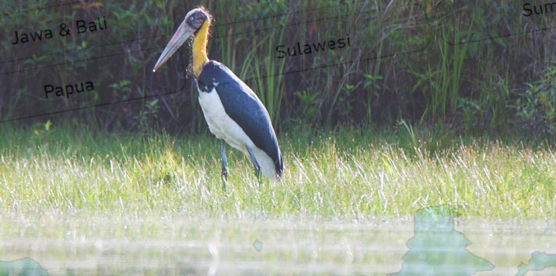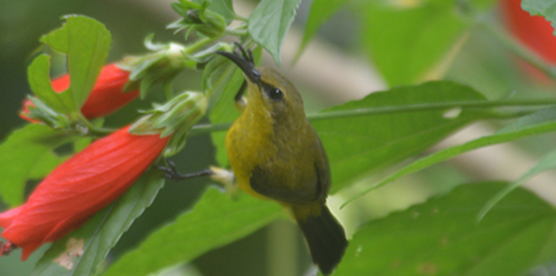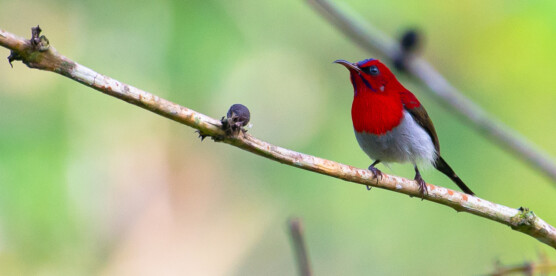The State of Indonesia's Birds 2024
Bird diversity is dynamic in any given place. As environmental conditions change and new information becomes available, our understanding of bird diversity continues to evolve. In 2024, bird diversity in Indonesia is still changing. In the meantime, documenting these changes is important as it provides a key basis for determining conservation priorities.
Burung Indonesia summarized all available information from various sources about changes in bird diversity in Indonesia and released it in The State of Indonesia's Birds. The State of Indonesia's Birds is a summary of the latest information on all bird species spread across Indonesia. The information contained in here is the result of searches from various sources, such as scientific publications, validated records by birdwatchers, and discussions with experts at research institutions and universities. The discussions involved experts in conservation, taxonomy and ecology. The main taxonomic basis used in The State of Indonesia's Birds follows the Handbook of the Birds of the World (HBW) and BirdLife International (HBW & BirdLife International, 2023).
Every year since 2014, Burung Indonesia has updated data on the status of birds in Indonesia, including the number of species, taxonomic changes, endemicity and threat status. Apart from being a practical reference for bird and habitat conservation, the public can also access this data as a reference for scientific resources.
Bird Diversity Changes in Indonesia
A search of information throughout 2023 found that bird species richness in Indonesia in early 2024 reached 1836 species, an increase of ten species from the previous year (1826 species in early 2023). Several factors influenced this change, mainly due to taxonomic splits and new records of bird species distributed across Indonesia. Taxonomic lumps also resulted in a shrinking number of species.
No less than eight bird species underwent taxonomic splits. This resulted in nine new species, adding to Indonesia's bird species richness. Meanwhile, five other species are known to occur in Indonesia for the first time.
Thus, 14 species were added to the list. The list of species can be seen in Table 1 below.
Table 1. List of taxonomic split species and new bird encounter records for Indonesia.
| No. | Latin Name | Nama Lokal | Catatan |
|---|---|---|---|
| 1 | Larus genei | Slender-billed Gull | New distribution records in Indonesia; individuals recorded migrating to Sumatra |
| 2 | Macropygia tenuirostris | Philippine Cuckoo-dove | New distribution record in Indonesia; recorded presence in Central Kalimantan from eBird observation data. |
| 3 | Pterodroma neglecta | Kermadec Petrel | New distribution records in Indonesia; presence in Papua recorded from eBird observation data. |
| 4 | Ardenna grisea | Sooty Shearwater | New distribution records in Indonesia; presence in Papua recorded from eBird observation data. |
| 5 | Terpsiphone paradisi | Indian Paradise-flycatcher | New distribution record in Indonesia; recorded presence in Aceh from eBird observation data. |
| 6 | Charadrius atrifrons | Tibetan Sandplover | Charadrius mongolus and Charadrius atrifron were previously lumped together as Charadrius mongolus (HBW and BirdLife International, 2022), but Charadrius atrifron was split based on plumage characters, vocal differences, and deep genetic differences (Livezey, 2010; Wei et al., 2022). |
| 7 | Macropygia cinnamomea | Enggano Cuckoo-dove | Macropygia emiliana and Macropygia cinnamomea were previously grouped as Macropygia emiliana (del Hoyo & Collar, 2014) but have been separated based on morphological and vocalization characters (Ng et al., 2016). |
| 8 | Ceyx rufidorsa | Rufous-backed Dwarf-kingfisher | Ceyx erithaca and Ceyx rufidorsa were previously lumped together as Ceyx erithaca (del Hoyo and Collar 2014) despite being previously split (e.g. Sibley & Monroe, 1990). Lim et al. (2010) provide a convincing rationale for genetic differentiation at the species level. |
| 9 | Oriolus consobrinus | Ventriloquial Oriole | Oriolus xanthonotus and Oriolus consobrius were previously grouped as Oriolus xanthonotus (HBW & BirdLife International, 2022) but were split based on phylogenomic, bioacoustic, biometric and morphological analysis (Rheindt et al., 2022). |
| 10 | Zosterops dehaani | Morotai White-eye | Zosterops dehaani is separated from Zosterops atriceps based on morphology, bioacoustics and ecology (Rheindt & Eaton, 2018). |
| 11 | Pomatorhinus bornensis | Sunda Scimitar-babbler | Pomatorhinus montanus and Pomatorhinus bornensis were previously grouped as Pomatorhinus montanus (HBW & BirdLife International, 2022) but separated based on differences in plumage characters, vocalizations, habitat/altitude, and behavior (Eaton et al., 2016). |
| 12 | Ninox rotiensis | Rote Boobook | Ninox boobook, Ninox rotiensis, Ninox fusca and Ninox plesseni were previously grouped within Ninox boobook (del Hoyo & Collar, 2014) but were separated based on genetic differences and vocalization differences (Gwee et al., 2017). |
| 13 | Ninox fusca | Timor Boobook | s.d.a |
| 14 | Ninox plesseni | Alor Boobook | s.d.a |
From the table above, there are also five bird species that are new records for Indonesia, including Slender-billed Gull (Larus genei), Philippine Cuckoo-dove (Macropygia tenuirostris), Kermadec Petrel (Pterodroma neglecta), Sooty Shearwater (Ardenna grisea), and Indian Paradise-flycatcher (Terpsiphone paradisi). Slender-billed Gull sightings are known from birdwatchers in Sumatra who monitored its migratory presence in South Sumatra Province (Iqbal et al., 2023). Meanwhile, the presence records of the other four species in Indonesia were obtained from extracting field observation data collected by birdwatchers in various regions to eBird. The use of citizen science platforms such as eBird is becoming increasingly popular, as they offer convenience in the process of recording and documenting observations, as well as facilitating the exchange of information between observers. On the other hand, citizen involvement in data collection allows the diversity of bird species in Indonesia to be monitored more inclusively and systematically. Therefore, citizen science platforms and citizen scientists are now also playing an important role in providing data and information for bird habitat conservation and management in Indonesia.
However, the long list of bird species in Indonesia has also shrunk due to taxonomic lumping. A total of nine bird species in Indonesia were merged into five species. Four bird taxa became subspecies or races of existing bird species, resulting in a reduction of four species from the previous list. The list of birds that experienced taxonomic lumping is as follows.
Table 2. List of species affected by toxonomic lumping.
| No. | Latin Name | Nama Lokal | Catatan |
|---|---|---|---|
| 1 | Ducula pinon | Pinon's Imperial-pigeon | Ducula salvadorii (distribution on D'Entrecasteaux Island and Louisiade Islands) became a subspecies of D. Pinon again. This taxonomy lumping has no impact on reducing the number of species in Indonesia because Ducula salvadorii is not distributed in Indonesia. |
| 2 | Ramphiculus fischeri | Red-eared Fruit-dove | Ramphiculus fischeri was previously split into R. fischeri and R. meridionalis (del Hoyo & Collar, 2014), previously placed in the genus Ptilinopus and merged as Ramphiculus fischeri (HBW & BirdLife International, 2023). |
| 3 | Actenoides princeps | Scaly-breasted Kingfisher | Actenoides regalis became a subspecies of A. princeps again (Sibley & Monroe, 1990) because race regalis has no encounter records and is known only from two specimens that are likely to be substantially unknown variations of A. princeps (HBW & BirdLife International, 2023). |
| 4 | Eumyias indigo | Indigo Flycatcher | Eumyias indigo and Eumyias ruficrissa were previously separated (del Hoyo & Collar, 2016) but have similar vocalizations (Boesman, 2016) and re-examination of specimen material suggests that the differences may be less marked than previously thought. |
| 5 | Tyto novaehollandiae | Australasian Masked-owl | Tyto almae (del Hoyo & Collar, 2014) was previously split from T. novaehollandiae following Sibley & Monroe (1990), however genetic assessments showed T. almae to have no significant differences with T. novaehollandiae (Jønsson et al., 2013; Uva et al., 2018). |
The State of Indonesia's Endemic Birds
Indonesian endemic birds are defined as bird species that are only distributed within the administrative boundaries of Indonesia. The taxonomic split that occurred also affected the number and species composition of Indonesia's endemic birds. 15 species were newly listed during this period, four of which are restricted to Indonesia. The total number of endemic bird species in Indonesia in 2024 is 542 species. This strengthens Indonesia as the country with the most endemic bird species in the world. The four species and their distribution are described in the following table.
Table 3. New Indonesian endemic species and their distribution areas.
| No. | Latin Name | Nama Lokal | Persebaran |
|---|---|---|---|
| 1 | Macropygia cinnamomea | Enggano Cuckoo-dove | Endemic to Enggano Island (Bengkulu) |
| 2 | Ninox rotiensis | Rote Boobook | Endemic to Rote Island (East Nusa Tenggara) |
| 3 | Ninox plesseni | Alor Boobook | Endemic to Alor Island (East Nusa Tenggara) and surrounding islands, such as Pantar and Atauro |
| 4 | Zosterops dehaani | Morotai White-eye | Endemic to Morotai Island (North Maluku) |
Indonesia is known to have seven avifauna regions where each region has a unique diversity of bird species (Sukmantoro et al., 2007). Endemic species are also distributed relatively unevenly between these avifauna regions. Most (169 species, 31%) of Indonesia's endemic species are distributed in Sulawesi, followed by Maluku (23%), and Nusa Tenggara (20%). This also makes the Wallacea region, which encompasses these three regions, a hotspot for Indonesia's endemic bird species. Kalimantan has the least number of endemic species (6 species, 1%) because most of the island's endemic bird species are also distributed in Malaysia.
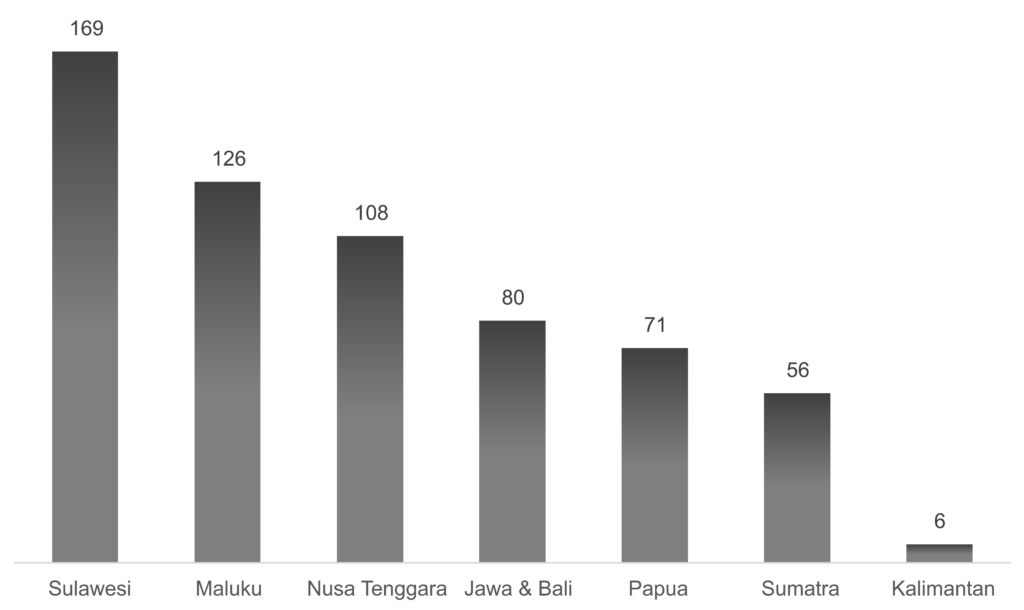
Figure 1. Number of Indonesian endemic bird species by avifauna range
The Threatened Status of Birds in Indonesia
Figure 2. Threat status categories based on the IUCN Red List
There were considerable changes in the threat status of bird species during this period. BirdLife International's annual evaluation of the IUCN Red List showed that there were changes in the threat status of 62 bird species in Indonesia (Figure 3). These changes included an upgrade of eight species from the low threat category to the higher risk of threat category. In contrast, 40 other species were placed in a lower threat category than before. In addition, another 14 species were newly evaluated and assigned a threat category, including nine new species resulting from taxonomic splits.
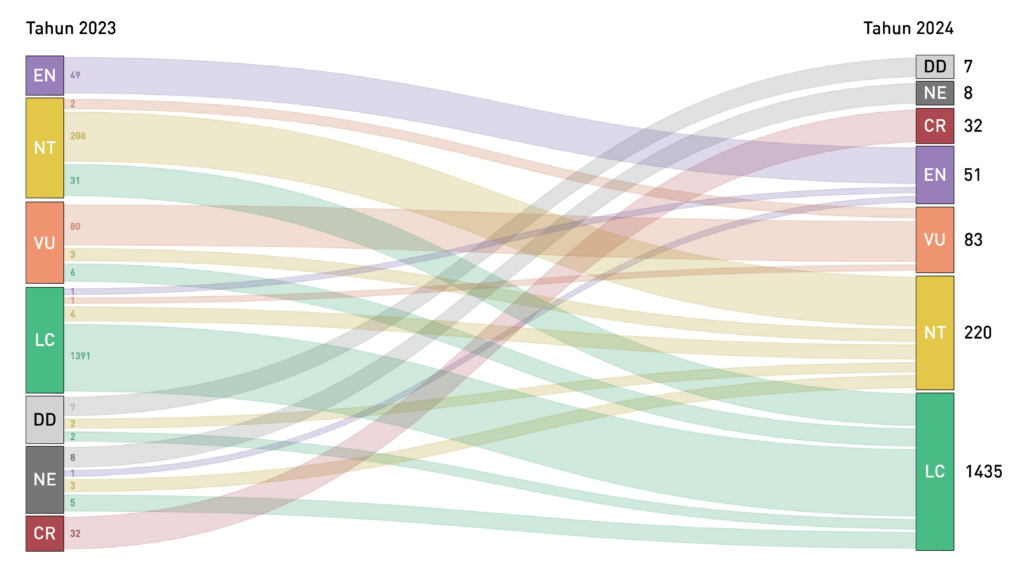
Figure 3. Illustration of changes in the number of bird species based on the 2023 and 2024 IUCN Red List
From the eight species that increased in threat status, four species were evaluated as globally threatened. Three species in the Vulnerable (VU) category are the Large Frogmouth (Batrachostomus auritus), Cinnamon-rumped Trogon (Harpactes orrhophaeus), and Javan Scimitar-babbler (Pomatorhinus montanus), and one species in the Endangered (EN) category is the Siberian Sandplover (Charadrius mongolus). According to IUCN (2023), forest destruction and degradation significantly reduced the populations of Large Frogmouth and Cinnamon-rumped Trogon. Meanwhile, the Javan Scimitar-babbler population is significantly affected due to the threat of hunting for trade and pets. The Siberian Sandplover faces a wide range of threats during its migration period, such as predation and reclamation of breeding grounds and habitat degradation at migration sites.
A total of 40 species were downgraded to lower threat categories, generally to the Near Threatened (NT) and Least Concern (LC) categories (Figure 3). From the IUCN evaluation (2023), the downgrades were generally due to new information and a new understanding of populations and threat levels. Some species were found to have larger population size estimates than previously thought and therefore did not reach the threshold of the higher threat category.
Another 14 species were only evaluated this year. Snow Mountain Robin (Petroica archboldi), White-faced Plover (Charadrius dealbatus), Starry Owlet-nightjar (Aegotheles tatei), and Vogelkop Owlet-nightjar (Aegotheles affinis) were previously categorized as Data Deficient (DD). However, with the addition of new information on their distribution and population, the four species are now evaluated in the NT, LC, LC, and NT categories. The Wangi-wangi White-eye (Zosterops paruhbesar) is a species that was only evaluated for its threat status this year, although it has been known to the scientific world since it was described in 2022. Its relatively small population size, which is only distributed on Wangi-Wangi Island, and the high threat posed by habitat loss and poaching have led to the species being immediately categorized as Endangered (EN) (IUCN, 2023).
Closing
Bird diversity in Indonesia is changing dynamically from year to year. Taxonomic revisions have contributed greatly to the increase in bird species diversity in Indonesia by revealing bird taxa that were previously 'hidden' within more complex species classifications. The contributions of citizen scientists through various citizen science platforms are also becoming increasingly important. Data collected voluntarily by citizen scientists can be a valid reference in monitoring bird diversity in Indonesia. This is also what encouraged Burung Indonesia to develop the citizen science platform AMATISEKITAR to open the widest possible opportunity for people who want to contribute to updating data and information on bird diversity.
A compilation of data from recent years shows that the increase in bird diversity also implies an increase in the number of endemic bird species in Indonesia. The results also show Wallacea as the main distribution area for endemic species. This was expected given the unique biogeographic history of Wallacea's islands, which have a much higher speciation rate than other regions.
Despite the advancing knowledge of Indonesia's bird diversity, many mysteries about the biology and life history of bird species remain unknown. This lack of information also makes it more difficult to assess threat status. More research, observations and expeditions are needed in the future to fill these knowledge gaps. Updating this information ultimately aims to support more effective bird conservation efforts in order to achieve the preservation of bird diversity in Indonesia.
Reference:
Boesman, P. (2016). Notes on avian vocalizations of proposed or potential taxonomic splits. Multiple species files.
del Hoyo, J., & Collar, N. J. (2014). HBW and BirdLife International Illustrated Checklist of the Birds of the World, 1: Non-Passerines. Lynx Edicions.
del Hoyo, J., & Collar, N. J. (2016). HBW and BirdLife International Illustrated Checklist of the Birds of the World, 2: Passerines. Lynx Edicions.
Eaton, J. A., Balen, B. van, Brickle, N. W., & Rheindt, F. E. (2016). Birds of the Indonesian Archipelago. Greater Sundas and Wallacea. Lynx Edicions.
Gwee, C. Y., Christidis, L., Eaton, J. A., Norman, J. A., Trainor, C. R., Verbelen, P., & Rheindt, F. E. (2017). Bioacoustic and multi-locus DNA data of Ninox owls support high incidence of extinction and recolonisation on small, low-lying islands across Wallacea. Molecular Phylogenetics and Evolution, 109, 246–258. https://doi.org/10.1016/j.ympev.2016.12.024
HBW, & BirdLife International. (2022). Handbook of the Birds of the World and BirdLife International Digital Checklist of the Birds of the World. Version 6. BirdLife International. http://datazone.birdlife.org/userfiles/file/Species/Taxonomy/HBW-BirdLife_Checklist_v8_Dec23.zip
HBW, & BirdLife International. (2023). Handbook of the Birds of the World and BirdLife International Digital Checklist of the Birds of the World. Version 8. BirdLife International. http://datazone.birdlife.org/userfiles/file/Species/Taxonomy/HBW-BirdLife_Checklist_v8_Dec23.zip
Iqbal, M., Absori, A., Prabowo, A., Setiawan, A., Handoko, D., Mulyani, Y. A., Hadiwijaya, S., Saputro, Y. D., Yustian, I., & Zulkifli, H. (2023). Slender-Billed Gull Chroicocephalus Genei, a New Bird for Indonesia. Marine Ornithology, 51(2), 179–180.
IUCN. (2023). The IUCN Red List of Threatened Species. Version 2020-3. https://www.iucnredlist.org
Jønsson, K. A., Poulsen, M. K., Haryoko, T., Reeve, A. H., & Fabre, P.-H. (2013). A new species of masked-owl (Aves: Strigiformes: Tytonidae) from Seram, Indonesia. Zootaxa, 3635(1), 51–61. https://doi.org/10.11646/zootaxa.3635.1.5
Lim, H. C., Zou, F., Taylor, S. S., Marks, B. D., Moyle, R. G., Voelker, G., & Sheldon, F. H. (2010). Phylogeny of magpie‐robins and shamas (Aves: Turdidae: Copsychus and Trichixos ): implications for island biogeography in Southeast Asia. Journal of Biogeography, 37(10), 1894–1906. https://doi.org/10.1111/j.1365-2699.2010.02343.x
Livezey, B. C. (2010). Phylogenetics of modern shorebirds (Charadriiformes) based on phenotypic evidence: analysis and discussion. Zoological Journal of the Linnean Society, 160(3), 567–618. https://doi.org/10.1111/j.1096-3642.2010.00635.x
Ng, E. Y. X., Eaton, J. A., Verbelen, P., Hutchinson, R. O., & Rheindt, F. E. (2016). Using bioacoustic data to test species limits in an Indo-Pacific island radiation of Macropygia cuckoo doves. Biological Journal of the Linnean Society, 118(4), 786–812. https://doi.org/10.1111/bij.12768
Rheindt, F. E., & Eaton, J. A. (2018). Notes on the taxonomy of Cream-throated White-eye Zosterops atriceps and the biogeography of the Northern Moluccas. BirdingASIA, 30, 48–53.
Rheindt, F. E., Wu, M. Y., Movin, N., & Jønsson, K. A. (2022). Cryptic species-level diversity in Dark-throated Oriole Oriolus xanthonotus. Bulletin of the British Ornithologists’ Club, 142(2). https://doi.org/10.25226/bboc.v142i2.2022.a10
Sibley, C. G., & Monroe, B. L. (1990). Distribution and Taxonomy of Birds of the World. Yale University Press.
Sukmantoro, W., Irham, M., Novarino, W., Hasudungan, F., Kemp, N., & Muchtar, M. (2007). Daftar Burung Indonesia No. 2. In Indonesian Ornithologists’ Union. Indonesian Ornithologists’ Union. https://doi.org/10.1017/CBO9781107415324.004
Uva, V., Päckert, M., Cibois, A., Fumagalli, L., & Roulin, A. (2018). Comprehensive molecular phylogeny of barn owls and relatives (Family: Tytonidae), and their six major Pleistocene radiations. Molecular Phylogenetics and Evolution, 125, 127–137. https://doi.org/10.1016/j.ympev.2018.03.013
Wei, C., Schweizer, M., Tomkovich, P. S., Arkhipov, V. Y., Romanov, M., Martinez, J., Lin, X., Halimubieke, N., Que, P., Mu, T., Huang, Q., Zhang, Z., Székely, T., & Liu, Y. (2022). Genome-wide data reveal paraphyly in the sand plover complex ( Charadrius mongolus/leschenaultii ). Ornithology, 139(2). https://doi.org/10.1093/ornithology/ukab085



